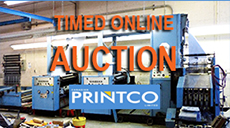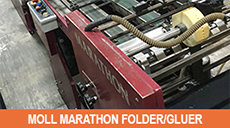
|
|
| Home › Articles › Here |
  |

|
||||||||||||||
| By: Nick Howard | Date: August 2010 | Contact the Author |
|||||||||||||||
| Cont'd from Part 1 |
|||||||||||||||
| Harris originated the off-press console
and, had they not abandoned sheetfed
manufacturing in 1975, could have dominated the press market. America’s standard
of living, being far in excess of the
rest of the world, meant that industrial
mass-market manufacturing had to be
done elsewhere and that meant moving
production to what at the time were,
lower cost countries like Germany and
Japan. For example, most of the ingenuity
in television technology rose out of California,
but Japan purposely developed the
foundries needed to build it all. Much of Japan’s reputation for technological innovation is the result of American spirit, realizing of course that the Pacific country has successfully leveraged its TV-building origins. The American printer is also very unique. While the rest of the world settled for a 4-colour press, for example, it was an American who first suggested why not make it five or six, or even eight, colours? Why not give the customer a 4- colour job but with his special or varnish in-line? That too is how the tower coater was engineered. Although not an American invention (it actually originated out of Canada), the tower coater or blanket coater is now something the industry thinks of as a standard feature. Even now, parts of the printing world cannot fathom why anyone would want a 6- or 8-colour press. Unless it is for labels or sometimes packaging, how could it be that the average American printer needs such a machine? Still today, I am often asked this question when working with printers from outside North America and Europe. All that extra power... the extra length! Why? Here’s why: Americans are competitive. They do not need – or even want – the person building the machine to instruct them. They want a technological edge, something the guy down the street cannot do. And this is an attitude that still prevails in printing, despite the cries from its old codgers, because there is always a next wave of technology ready to disrupt what seems like the most-efficient production process. You do not have to be born an American to think like one, even if you are in the printing industry. Taken for granted There is a vuvuzela-like drone about the dwindling need for the graphical communication of information and ideas via the printing press, but no one, including commentators who have followed this industry for decades, has any concrete measure on what our industry will look like a few years down the road. We can possibly see that search engines will continue to mature to an extent that soon we can Google a specific topic within a specific location. This will further erode the need for directory businesses including those that gravitated to the Web already. Print, American-style, will only become cheaper in the near term so, that as a medium, it can remain competitive against all of the other on-screen forms of communications. Not to mention the fact that trade printing, with lower-cost production as its reason for being, traces its origins to North America. While BRIC regions of the world continue to grow their printing economies, what has happened in America will also eventually take hold there, almost as quickly as you can say Benjamin Franklin. |
|||||||||||||||
 |
|||||||||||||||
|
China, in particular, is a vast country
with a huge population. Despite their
very different political systems, I believe
that the Chinese understand and appreciate
the American dream and, although
China is rife with what we see as significant
human-rights issues, there is also a
healthy entrepreneurial spirit growing
there. Much like the atmosphere of the United States back in the 1950s, business people in China are willing to make huge sacrifices and they are eager to push the rest of the world. Low costs have built the Chinese economy and could very well sustain it, but sooner or later even China may be seeking other lower cost countries for manufacturing. Look for stability in our North American printing industry as we head toward 2011. Despite all of the negative rumblings, from a business perspective, it is our good fortune to be neighbours with the U.S. and its economy. Even though we like to talk about how wonderful our banking system is, I would not count out the next wave of growth from south of the border. Credit will again flow when the financial markets stabilize. Once credit is flowing, competition will escalate and confidence in the future will return. Canadians will be only too happy to join our neighbours for the ride, praising the ingenuity of America, but perhaps this time a little more prepared for economic correction – on a global scale. It is very doubtful that the growth of the 1990s will ever return to the printing industry, and do not be surprised if you cannot recognize North American printing by the end of 2011, because we are about to see an industry that has never been more focused or better managed. We should remember this the next time someone berates the United States as the land of excess and overindulgence, particularly when out on the shop floor and using so many press features that have been developed in that country. America is like no other country in the world, and everywhere you go in the world you will see signs of America mixed in with so many domestic brands. Yes the rest of the world should again look to America as the beacon of what Man was put on this earth to do: Advance, create and make the world a better place than before. Sometimes being a leader means making mistakes. Learning from them is critical. America should be commended by all economies as the Bastian of hope eternal. God Bless America. |
|||||||||||||||
| Contact the Author | |||||||||||||||
|
|||||||||||||||





